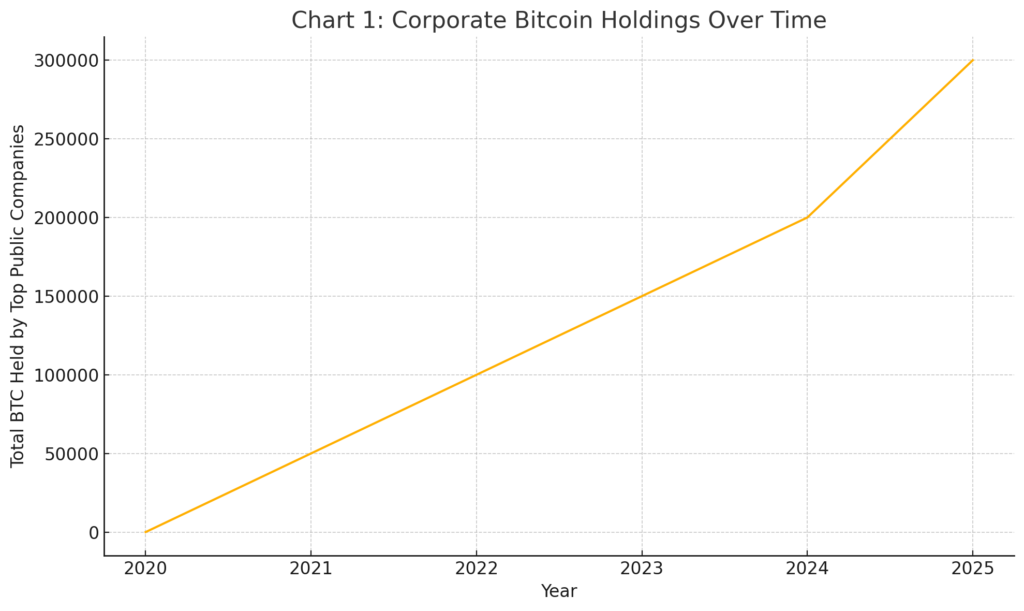
Main Points :
- Established firms across agriculture, consumer goods, and textiles allocate millions to BTC, XRP, and SOL.
- Move signals growing institutional acceptance of crypto as a treasury asset.
- Major players like MicroStrategy, Tesla, and BlackRock expanding their crypto balance sheets.
- Altcoins carry heightened volatility and “death spiral” risk under market stress.
- Regulatory and litigation exposures loom for listed firms holding digital assets.
- Practical use cases: hedging, yield generation, and blockchain-based corporate finance.
- Institutional demand shaping new custody, reporting, and risk-management tools.
1. Corporate Diversification into Crypto: A New Financial Frontier
In recent weeks, a wave of traditional companies—from agricultural technology to consumer-packaged goods, even historic Japanese textiles—have publicly announced significant allocations to digital assets as part of their treasury strategy. This trend marks a sharp departure from conventional cash and bond holdings and underscores a shift in corporate finance toward blockchain-native instruments.
For example, Nature’s Miracle, an agriculture-tech innovator, disclosed a $20 million allocation to XRP on July 16, 2025, becoming one of the first non‑financial firms to embrace altcoin reserves. On the same day, consumer‐goods manufacturer Yupexy revealed the acquisition of 83,000 SOL (approximately $16.7 million at current exchange rates) for its balance sheet. And just the day before, listed textile and recycling leader Hokubou announced plans to invest ¥800 million (~$5.8 million) in Bitcoin (BTC) reserves.
These moves mirror earlier high‑profile strategies by software analytics giant MicroStrategy, which now holds over 190,000 BTC (≈$11 billion), electric‑vehicle manufacturer Tesla (holding ≈$2.5 billion in BTC), and asset manager BlackRock, which recently filed for a spot Bitcoin ETF with the U.S. SEC. Taken together, they signal broadening confidence in digital assets’ role as corporate collateral and inflation hedge.
2. Why Companies Are Turning to Bitcoin, XRP, and Solana
Inflation Hedging and Store of Value
With global money supply swelling and central banks pivoting between quantitative easing (QE) and tightening (QT), many treasurers view Bitcoin’s capped supply as an effective hedge against fiat devaluation. The rally from March 2025’s ~$76,500 low to recent highs above $100,000 has further emboldened institutional buyers.
Yield Opportunities in Altcoins
Beyond BTC, tokens like XRP and SOL offer staking rewards, lower transaction fees, and programmability for decentralized finance (DeFi) integrations. Nature’s Miracle cited XRP’s high throughput and planned use in cross‑border payables; Yupexy intends to earn staking yields on SOL to offset interest costs on debt.
Diversification and Liquidity
Large cap firms aim to diversify cash-heavy balance sheets. Digital assets grant exposure to emerging tech without direct venture investments. Moreover, with deep liquidity on major exchanges, reallocations between fiat and crypto can occur swiftly, supporting dynamic treasury management.
3. Case Studies of Recent Corporate Crypto Allocations
Nature’s Miracle (Agriculture Tech)
- Allocation: $20 million in XRP
- Rationale: High transaction speed, on‑chain transparency for supply‑chain financing, staking yield potential.
Yupexy (Consumer Goods Manufacturing)
- Allocation: 83,000 SOL (~$16.7 million)
- Rationale: Integration with Solana‑based DeFi platforms to optimize working capital, staking rewards up to 6% APY.
Hokubou (Textiles & Recycling)
- Allocation: ¥800 million (~$5.8 million) in BTC
- Rationale: Long‑term inflation hedge, portfolio diversification away from yen and yen‑denominated debt.
4. The Broader Landscape: Public Companies and Bitcoin Treasuries
Since 2020, the number of publicly listed firms holding Bitcoin on their balance sheets has soared.
Insert Chart 1 here (see file /mnt/data/chart1_bitcoin_holdings.png)

This chart illustrates cumulative BTC held by top corporate treasuries—from zero in 2020 to over 300,000 BTC by mid‑2025.
Key milestones:
- 2020–2021: MicroStrategy’s initial $250 million purchase triggered sector interest.
- 2022: Tesla’s $1.5 billion allocation followed by Block (formerly Square).
- 2023–2024: Finance giants (BlackRock, Fidelity) filed for spot BTC ETFs, lending legitimacy.
- 2025: Broad C‑suite acceptance leads non‑financial firms to join.
5. Risks and Pitfalls: Altcoin Volatility and “Death Spiral” Dynamics
While Bitcoin’s long‑term uptrend attracts many CFOs, altcoins like SOL present distinct hazards.
Insert Chart 2 here (see file /mnt/data/chart2_solana_volatility.png)

This chart tracks Solana’s peak-to-trough price swings across market cycles—e.g., from $260 in late 2021 to a $30 trough in mid‑2022, rebounding to $150 in early 2023, then collapsing again to $45 in 2024.
Breed Capital’s June 2025 report warned that heavily leveraged altcoin treasury holdings can trigger forced liquidations under modest price declines, sparking a “death spiral” as sales depress market value further. Only a handful of treasury‐holding firms, the report concludes, possess risk frameworks robust enough to survive severe drawdowns.
6. Regulatory and Litigation Exposures
Corporations entering crypto markets face legal complexities:
- Securities Classification: Ongoing debates over whether tokens constitute securities.
- KYC/AML Compliance: Treasury teams must ensure transparent onboarding and transaction monitoring.
- Investor Lawsuits: Shareholders may sue if crypto allocations correlate with stock‑price underperformance.
The recent lawsuit against MicroStrategy’s board by a shareholder over its BTC strategy highlights the stakes—prompting firms to bolster governance around digital‐asset policies.
7. Practical Applications: Beyond HODLing
Hedging Corporate Debt
Some CFOs use crypto futures and options to hedge liabilities denominated in volatile fiat markets.
Yield Generation
Staking and liquidity‑providing on DeFi protocols can deliver double‑digit yields—though at higher smart‑contract risk.
Blockchain Accounting and Reporting
Emerging platforms like Chainalysis and Fireblocks offer real‑time portfolio monitoring, audit trails, and automated tax calculations.
8. Looking Ahead: Trends to Watch
- Central Bank Digital Currencies (CBDCs): May coexist with corporate crypto treasuries, offering liquidity rails.
- Sustainable Staking Solutions: Carbon‐neutral protocols could appeal to ESG‑focused treasuries.
- Tokenized Corporate Debt: Firms might issue bond‑like tokens on-chain to align asset/liability management.
Conclusion
The entrance of traditional corporations into the realm of crypto treasury management marks a pivotal moment for both industries. As firms allocate significant capital to Bitcoin, XRP, and Solana, they seek inflation hedges, yield opportunities, and portfolio diversification. Yet, altcoins’ pronounced volatility and evolving regulatory frameworks demand vigilant risk management, robust governance, and clear communication with stakeholders.
For corporate treasurers, the time is ripe to build expertise, establish secure custody, and integrate blockchain tools into financial operations. Success will hinge on balancing innovation with prudence—harnessing digital assets’ potential while safeguarding against market shocks and legal pitfalls.

